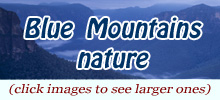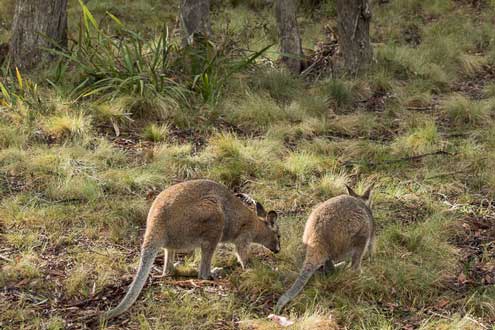Relative to the widespread shrubby forests on sandstone, the grassy woodlands are fringe communities in the Greater Blue Mountains.
They occupy just over 2% of the landscape, occurring at both low and high altitudes on deeper soils of moderate to high fertility derived from shales and granites.
They occupy the rain shadows of both the coast and ranges.
They have a diverse understorey of grasses and herbs, few shrubs, and their trees are often well-spaced.
Canopy species include various box, red gum and ironbark eucalypts and, at high altitudes, species from the ash group of eucalypts.
There are five classes of grassy woodland in the Greater Blue Mountains, each with quite limited occurrence.
- Coastal Valley Grassy Woodlands
- Subalpine Woodlands
- Tableland Clay Grassy Woodlands
- Southern Tableland Grassy Woodlands and Western Slopes Grassy Woodlands
Coastal Valley Grassy Woodlands
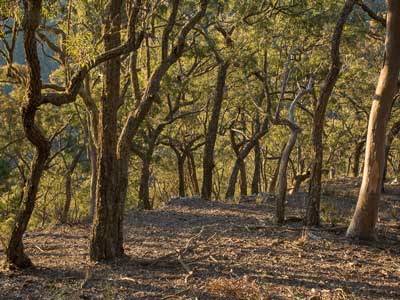 Coastal Valley Grassy Woodland (Wild Dog Mountains)
Coastal Valley Grassy Woodland (Wild Dog Mountains)
with Narrow-leaved Ironbarks (Eucalyptus crebra) and Grey Gum (E. punctata) (Ian Brown)
These locations are in the coastal rain shadow.
Tall trees of Forest Red Gum (Eucalyptus tereticornis) are characteristic of these woodlands, as are Rough-barked Apple (Angophora floribunda) and Narrow-Leaved Ironbark (Eucalyptus crebra).
Subalpine Woodlands
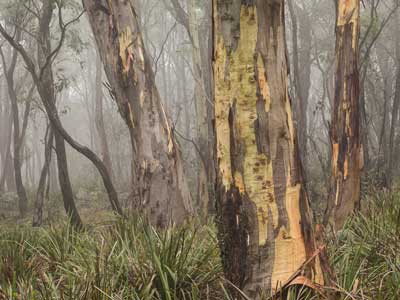 Subalpine Woodland (Boyd Plateau)
Subalpine Woodland (Boyd Plateau)with Snow Gums (Eucalyptus pauciflora) and Lomandra sp. (Ian Brown)
These woodlands are somewhat shorter than the coastal valley grassy woodlands.
The main canopy species are Snow Gum (Eucalyptus pauciflora) and Mountain Gum (Eucalyptus dalrympleana).
The ground cover is dominated by the Large Tussock Grass (Poa sieberiana).
Tableland Clay Grassy Woodlands
Tableland Clay Grassy Woodlands also occur at high altitudes; however, they are restricted to the richer soils derived from basalt.
These woodlands support tall trees of Mountain Gum (Eucalyptus dalrympleana), Ribbon Gum (Eucalyptus viminalis), Yellow Box (Eucalyptus melliodora) and Blackwood (Acacia melanoxylon).
In the Greater Blue Mountains, these woodlands are highly restricted, but they are more widespread elsewhere in NSW, occurring extensively on the Northern and Southern Tablelands.
Examples can be found in the vicinity of Mount Werong and Wombeyan Caves.
Southern Tableland Grassy Woodlands and Western Slopes Grassy Woodlands
At lower altitudes, these subalpine and high-tableland woodlands are replaced by Southern Tableland Grassy Woodlands and Western Slopes Grassy Woodlands.
The former grow on loamy soils in the rain shadow of the escarpment in the south-western part of the Greater Blue Mountains, south of Oberon.
In the Greater Blue Mountains, the most prominent examples are the upper reaches of the Abercrombie River where the canopy species are mainly Broad-leaved Peppermint (Eucalyptus dives) and Apple Box (Eucalyptus bridgesiana).
The latter occur in similar rain shadows north of Lithgow, including in the valleys of the Wolgan and Capertee Rivers and across northern Wollemi, where White Box (Eucalyptus albens) and Yellow Box (Eucalyptus melliodora) become prominent.
Both these classes of grassy woodland are at the eastern-most limit of their range in the Greater Blue Mountains, and are more common west of the ranges.
Threatened Ecological Communities of grassy woodlands
Shale/Sandstone Transition Forest (critically endangered) occurs in the lower mountains and White Box Yellow Box Blakely’s Red Gum Woodland (endangered) in the southern and western valleys.
Grassy Woodlands Flora
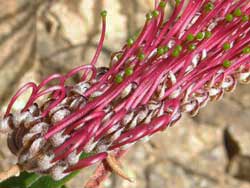 Grevillea aspleniifolia
Grevillea aspleniifolia
photo by: Alan Page
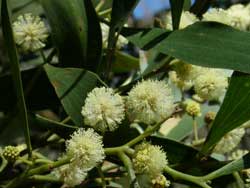 Blackwood (Acacia melanoxylon)
Blackwood (Acacia melanoxylon)
photo by: Alan Page
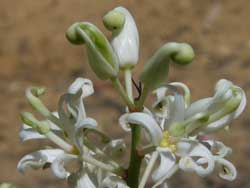 Crinkle Bush (Lomatia silaifolia)
Crinkle Bush (Lomatia silaifolia)
photo by: Alan Page
More Grassy Woodlands Landscapes
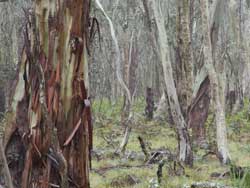 Subalpine Woodland, Boyd Plateau
Subalpine Woodland, Boyd Plateau
photo by: Ian Brown
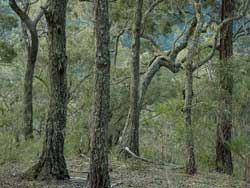 Coastal Valley Grassy Woodland
Coastal Valley Grassy Woodland
photo by: Ian Brown
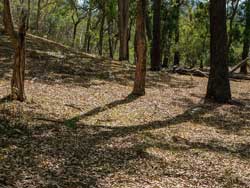 Coastal Valley Woodlands, Jenolan River
Coastal Valley Woodlands, Jenolan River
photo by: Ian Brown
Here on a small alluvial flat in the rainshadowed depths of the Jenolan River gorge, Rough-barked Apples (Angophora floribunda) dominate over a marsupial-grazed ‘lawn’ and summer leaf-fall.
